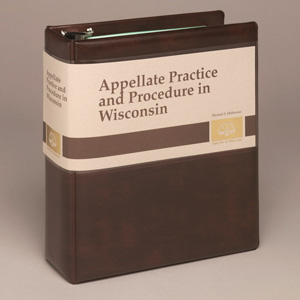
It is an exchange that happens in courthouses around Wisconsin: One lawyer dismisses Wisconsin Supreme Court authority as “just dicta” – the other retorts that there is no such thing as dicta under Wisconsin law.1 And, to be fair to the many lawyers who have made this mistake, Wisconsin law is littered with decisions treating would-be binding authorities as mere dicta. But the last time the Wisconsin Supreme Court took up the issue in a majority opinion, the court held unanimously in
Zarder v. Humana Insurance Co. that dicta does not exist in Wisconsin Supreme Court opinions: “to uphold the principles of predictability, certainty, and finality, the court of appeals may not dismiss a statement from an opinion by this court by concluding that it is dictum.”2
Since the time of that statement in 2011, however, the court’s composition has changed significantly, and it is not clear that a majority of the court will stand by
Zarder. As two justices presented the issue in a recent concurrence, is it “every jot and tittle, stray statement, or tangential footnote [of the Wisconsin Supreme Court] binding legal precedent that must be followed faithfully?”3
Dictum and Its Origin
“Dicta” and its singular form, “dictum,” come from the Latin phrase “obiter dictum,” meaning “something said in passing.”4 Since soon after our nation’s founding, courts have recognized the practical problems that may come from treating every word of an opinion as binding. Chief Justice John Marshall, for example, once cautioned that it “is extremely dangerous to take general
dicta” as binding,5 and explained that the “question actually before the Court is investigated with care, and considered in its full extent. Other principles which may serve to illustrate it, are considered in their relation to the case decided, but their possible bearing on all other cases is seldom completely investigated.”6
In Wisconsin, the courts have developed two general definitions of dictum. Under one line of cases, dictum is defined as “a statement or language expressed in a court’s opinion which extends beyond the facts in the case and is broader than necessary and not essential to the determination of the issues before it.”7 From this perspective, more than mere relation to the issues at hand is required for some discussion to be considered precedential: rather, the discussion must be
necessary and
essential to the determination of such issues. Another line of cases takes a different, less restrictive approach, under which the question is whether a statement was “germane to” the controversy. Under that standard, “when an appellate court of last resort intentionally takes up, discusses, and decides a question germane to, though not necessarily decisive of, the controversy, such decision is not a dictum but is a judicial act of the court which it will thereafter recognize as a binding decision.”8
Cook and
Zarder
Under Wisconsin law, as expressed by the supreme court in
Cook v. Cook, “[t]he supreme court is the only state court with the power to overrule, modify or withdraw language from a previous supreme court case.”9 The court reached this conclusion that the Wisconsin Court of Appeals cannot overrule its own published opinions for four primary reasons: “The court of appeals is a unitary court; published opinions of the court of appeals are precedential; litigants, lawyers and circuit courts should be able to rely on precedent; and law development and law defining rest primarily with the supreme court.”10 In the years after
Cook, lower courts seemingly applied it inconsistently. As one Wisconsin judge argued, faced with an inability to modify previous opinions, “panels sometimes distinguish[ ] a problematic case on exceedingly fine points, or on assumed facts.”11
 David P. Hollander, U.W. 2017, is an attorney with
Stafford Rosenbaum LLP, Madison, practicing commercial litigation with a focus on business disputes, real estate and construction, political law, and intellectual property litigation. He is a member of the State Bar of Wisconsin’s
Young Lawyers Division.
David P. Hollander, U.W. 2017, is an attorney with
Stafford Rosenbaum LLP, Madison, practicing commercial litigation with a focus on business disputes, real estate and construction, political law, and intellectual property litigation. He is a member of the State Bar of Wisconsin’s
Young Lawyers Division.
 Michael R. Fitzpatrick, Drake 1984, retired court of appeals judge and circuit court judge, serves as a mediator and arbitrator through
Fitzpatrick ADR. He also serves as a reserve judge, is an elected member of the American Law Institute contributing to the Restatement Third of Torts, and is on the faculty of the Wisconsin Judicial College. Judge Fitzpatrick was elected by Wisconsin’s judges to two terms on the Civil Jury Instruction Committee and the Judicial Council. He is a member of the State Bar of Wisconsin’s
Dispute Resolution Section board and the
Litigation Section.
Michael R. Fitzpatrick, Drake 1984, retired court of appeals judge and circuit court judge, serves as a mediator and arbitrator through
Fitzpatrick ADR. He also serves as a reserve judge, is an elected member of the American Law Institute contributing to the Restatement Third of Torts, and is on the faculty of the Wisconsin Judicial College. Judge Fitzpatrick was elected by Wisconsin’s judges to two terms on the Civil Jury Instruction Committee and the Judicial Council. He is a member of the State Bar of Wisconsin’s
Dispute Resolution Section board and the
Litigation Section.
The authors thank Jamie Kanchananakhin, U.W. 2025, for his valuable research contributions to this article.
This problem came to the fore in
Zarder. In that case, the court of appeals concluded that previous statements by the supreme court were “obviously off-the-cuff statements, made without any careful thought or analysis” and qualified as dicta.12 But one judge dissented, citing
Cook for the proposition that the court of appeals could not dismiss statements by the supreme court as mere dicta.13
The supreme court reversed the court of appeals.14 A unanimous supreme court acknowledged its “inconsistent guidance” on the definition and effect of dicta but, building on
Cook, unanimously concluded that lower courts may not dismiss prior published authority as dicta.15 By dismissing a statement as dictum, a court “necessarily withdraws or modifies” the opinion in which it appeared.16 The court of appeals “is not powerless,” however, and has two options in this scenario: “It may signal its disfavor […] by certifying the appeal to [the supreme court], explaining that it believes a prior case was wrongly decided. Alternatively, the court of appeals may decide the appeal, adhering to a prior case but stating its belief that the prior case was wrongly decided.”17
Is the Tide Turning on the Wisconsin Supreme Court?
While
Zarder was a unanimous decision of the supreme court, support for its holding may be eroding. In the accompanying sidebar we summarize, the best we are able, each current justice’s stance on the issue.
In 2023, Justice Hagedorn, joined by Justice Dallet, wrote a concurring opinion in
Wisconsin Justice Initiative Inc. v. Wisconsin Elections Commission designed to be “a clarion call to re-embrace dicta’s crucial role in understanding our case-deciding, precedent-setting function.”18 The two justices explained that “[j]ust because we stated in
Cook that the court of appeals cannot overrule itself does not mean it cannot disregard statements that were never binding in the first place,” particularly in light of the “traditional rule [ ] that only the rationale for a decision has precedential effect.”19 They explained that a strict application of
Zarder “reimagines our opinions as akin to legislation.”20 “But we don’t know what we don’t know. We make mistakes and misdescribe things and use imprecise language.”21 “Stray statements or tangential discussions in opinions should not bind future courts or demand a stare decisis analysis.”22 The justices proceeded to articulate a definition of dicta under which only the reasoning or rationale is binding precedent – the rest is not.23
There is likewise evidence that court of appeals judges believe
Zarder has gone, or will soon go, by the wayside. While the
Cook and
Zarder reasoning applies equally to published statements from the supreme court and the court of appeals,24 the court of appeals seems more receptive to treating its own statements as dicta.25 And Wisconsin courts continue to distinguish what might be called “dicta” in appropriate circumstances.26
The Federal Standard for Dicta
While the precise federal definition of dicta has varied to some degree depending on the court and the era, federal law has seemingly always recognized a practical approach to dicta.
Federal courts recognize the risks of treating every word a court states as binding.27 But federal courts also recognize that “[e]ven dicta provide insight into how the Supreme Court is likely to rule on an issue.”28 “The Court can hear only a small portion of all litigated disputes; it uses considered dicta to influence others for which there is no room on the docket.”29 Thus, the Court sometimes delivers a “message that, whether or not technically dictum, a court of appeals must respect, given the Supreme Court’s entitlement to speak through its opinions as well as through its technical holdings.”30
A Return to the Middle Ground
Zarder has proven unworkable for many of the reasons identified in Justice Hagedorn’s
Wisconsin Justice Initiative concurrence. As the Wisconsin Supreme Court recognized in
Cook, the court of appeals is primarily an error-correcting court, but “it necessarily performs a second function, that of law defining and law development, as it adapts the common law and interprets the statutes and federal and state constitutions in the cases it decides.”31 The solution contemplated by
Zarder is easier said than done – even when the court of appeals certifies a question, there is no guarantee that the supreme court will take the issue.32 In one instance, when two binding decisions conflicted with one another, the court of appeals certified the question to the Wisconsin Supreme Court three times without the supreme court resolving the conflict.33
By pulling back from
Zarder, the Wisconsin Supreme Court can mirror the pragmatic federal approach and return to a regime under which dicta “are by no means to be rejected as not entitled to be regarded at all; that while they are not binding, they are not without authority; neither is their use reprehensible.”34 After all, this was the court that once held that “some of the most sacred canons of the common law had their origin in the mere
dicta of some wise judges.”35
Where Do the Current Justices Stand on Dicta?
Dicta Denier
Justice Ann Walsh Bradley:Authored the unanimous
Zarder decision and has since reaffirmed her view that it was correctly decided, stating that as “the court of last resort in this state, our conclusions cannot be dicta.”36 Note, however, that Justice A.W. Bradley’s term expires on July 31, 2025, and she has indicated that she will not run for another term.
Dicta Proponents
Justice Brian Hagedorn:Wrote extensive concurring opinion in
Wisconsin Justice Initiative, arguing that lower courts must be able to treat some statements of the supreme court as dicta.
Justice Rebecca Frank Dallet:Joined Justice Hagedorn’s dictadiscussion in
Wisconsin Justice Initiative. Has also written that “dicta from the [ ]case has been applied inconsistently by the United States Supreme Court depending upon the nature of the facial challenge.”37
Chief Justice Annette Kingsland Ziegler:Views may not be as clear as Justice Hagedorn’s and Justice Dallet’s but has joined or authored decisions referring, at least in passing, to statements of the Wisconsin Supreme Court and the U.S. Supreme Court as dicta.38
Varying Views on Dicta
Justice Rebecca Grassl Bradley:In three opinions, has referred to statements by the Wisconsin Supreme Court, the Wisconsin Court of Appeals, and the U.S. Supreme Court as “dicta.”39 But, citing
Zarder, has also concluded that “[o]ur court does not recognize the concept of dicta, however.”40
Haven’t Addressed Dicta
Justice Jill J. Karofsky: Seemingly has not written on the subject. Joined Justice Dallet’s concurring opinion in
Wisconsin Justice Initiative but, unlike Justice Dallet, did not join Justice Hagedorn’s dicta-related concurrence.
Justice Janet C. Protasiewicz: Recently joined the court (elected in April 2023 and took office Aug. 1, 2023) and has not written on the subject.
Also of Interest
Get the Gold Standard for Your Next Appeal
 If you plan to appeal a case to the Wisconsin Court of Appeals or the Wisconsin Supreme Court, turn to
Appellate Practice and Procedure in Wisconsin, the standard reference on practice in both courts. The book’s 28 chapters provide basic information on appellate procedures, as well as sophisticated commentary on expedited appeals, briefing, oral argument, one-judge appeals, and other important topics.
If you plan to appeal a case to the Wisconsin Court of Appeals or the Wisconsin Supreme Court, turn to
Appellate Practice and Procedure in Wisconsin, the standard reference on practice in both courts. The book’s 28 chapters provide basic information on appellate procedures, as well as sophisticated commentary on expedited appeals, briefing, oral argument, one-judge appeals, and other important topics.
Several appendices provide additional resources, including a “Standards of Appellate Review” outline, prepared by the Hon. Thomas Hruz of the Wisconsin Court of Appeals, District III, and Nathan Petrashek, a Wisconsin Court of Appeals district staff attorney; numerous appellate court forms, prepared by the Clerk of the Wisconsin Supreme Court and Court of Appeals; and the full text of the Wisconsin Rules of Appellate Procedure. Both the print and Books UnBound versions include a complete set of fillable, unannotated forms via download.
To give your client the best representation possible on appeals, make
Appellate Practice and Procedure in Wisconsin your key resource.
Endnotes
1 One such exchange from an Oct. 31, 2023, argument in
Priorities USA v. Wisconsin Elections Commission, No. 2023-cv-1900 (Dane Cnty. Circuit Ct.), is available on Wisconsin Eye (beginning at minute 46):
https://wiseye.org/2023/10/31/dane-county-circuit-court-priorities-usa-et-al-vs-wisconsin-elections-commission-2/ (last visited Sept. 4, 2024).
2 Zarder v. Humana Ins. Co., 2010 WI 35, ¶ 58, 324 Wis. 2d 325, 782 N.W.2d 682.
3 Wisconsin Just. Initiative Inc. v. Wisconsin Elections Comm’n, 2023 WI 38, ¶ 140, 407 Wis. 2d 87, 990 N.W.2d 122.
4 Obiter Dictum, Black’s Law Dictionary (11th ed. 2019).
5 Alexander v. Baltimore Ins. Co., 8 U.S. 370, 379 (1808).
6 Cohens v. Virginia, 19 U.S. (6 Wheat.) 264, 399-400 (1821).
7 Zarder, 2010 WI 35, ¶ 52 n.19, 324 Wis. 2d 325 (quoting State v. Sartin, 200 Wis. 2d 47, 546 N.W.2d 449 (1996)).
8 Id. (quotingState v. Picotte, 2003 WI 42, ¶ 61, 261 Wis. 2d 249, 661 N.W.2d 381).
9 Cook v. Cook, 208 Wis. 2d 166, 189, 560 N.W.2d 246 (1997).
10
Id.
11 Steiner v. Steiner, 2004 WI App 169, ¶ 20, 276 Wis. 2d 290, 687 N.W.2d 740 (Dykman, J., dissenting).
12 Zarder v. Humana Ins. Co., 2009 WI App 34, ¶ 12, 316 Wis. 2d 573, 765 N.W.2d 839.
13 Id. ¶¶ 44-46 (Snyder, J., dissenting).
14 Zarder, 2010 WI 35, 324 Wis. 2d 325.
15 Id. ¶ 57.
16 Id.
17 Id. ¶ 54 (quoting
Cook, 208 Wis. 2d at 190).
18 Wisconsin Just. Initiative, 2023 WI 38, ¶ 139, 407 Wis. 2d 87 (Hagedorn, J., concurring).
19 Id. ¶ 144.
20 Id. ¶ 149.
21 Id. ¶ 150.
22 Id.
23 Id. ¶ 138 (“So while the reason or rationale for a decision (in Latin,
ratio decidendi) constitutes precedent, the other things said by a court do not. This is true even when the court comments on the law.”)
24 Zarder, 2010 WI 35, ¶ 54, 324 Wis. 2d 325 (“[W]e concluded that this court has the exclusive power to overrule, modify, or withdraw language from prior Wisconsin cases.”);
Cook, 208 Wis. 2d at 189 (“If the court of appeals is to be a unitary court, it must speak with a unified voice.”).
25 For example, the court has cited
Zarder’s definition of dicta, stating, “[u]nder these standards, we conclude that the language in [a previous court of appeals opinion] regarding the effect of the anti-assignment clause is dicta.”
Pepsi-Cola Metro. Bottling Co. Inc. v. Employers Ins. Co. of Wausau, 2022 WI App 45, ¶ 28, 404 Wis. 2d 337, 979 N.W.2d 627,
aff’d, 2023 WI 42, ¶ 28, 407 Wis. 2d 384, 990 N.W.2d 267. Likewise, another court of appeals panel recently rejected a party’s contention that a previous statement by the court of appeals was “arguably dicta” because it failed “to develop any viable contention that this court’s discussion of the [issue] was not germane to the controversy in that case, that it extended beyond the facts of the case, or was broader than necessary.”
Clarke v. SSM Health Care Corp., No. 2021AP908, 2023 WL 163847, ¶ 19 (Wis. Ct. App. Jan. 12, 2023) (unpublished) (review denied). In doing so, the court cited
Zarder – not for the proposition that there is no such thing as dicta but for the definition of dicta.
Id. (quoting
Zarder, 2010 WI 35, ¶¶ 52 n.19, 58, 324 Wis. 2d 325).
26
See, e.g.,
State v. Drachenberg, No. 2022AP2060-CR, 2023 WL 6629737, ¶ 25 n.9 (Wis. Ct. App. Oct. 12, 2023) (unpublished) (review denied) (the “court of appeals cannot disregard statement[s] from case law of our supreme court on the grounds that it is dicta […] Rather, as we explain in the text, this aspect of [the case] is distinguishable from the facts here.”).
27 See, e.g., Cohens, 19 U.S. 264;
Zarder, 2010 WI 35, 324 Wis. 2d 325.
28 Nabozny v. Optio Sols. LLC, 583 F. Supp. 3d 1209, 1213 (W.D. Wis. 2022),
aff’d, 84 F.4th 731 (7th Cir. 2023).
29 United States v. Bloom, 149 F.3d 649, 653 (7th Cir. 1998).
30 United States v. Skoien, 614 F.3d 638, 641 (7th Cir. 2010).
31 Cook, 208 Wis. 2d at 188.
32 “Certifications are granted on the basis of the same criteria as petitions to bypass.” S. Ct. Internal Operating Procedures III.B.2;
see also
https://www.wicourts.gov/sc/IOPSC.pdf (last visited Sept. 4, 2024).
33 State v. Prado, 2020 WI App 42, ¶ 36, 393 Wis. 2d 526, 947 N.W.2d 182,
aff’d, 2021 WI 64, 397 Wis. 2d 719, 960 N.W.2d 869.
34 Brown v. Chicago & N.W. Ry. Co., 102 Wis. 137, 78 N.W. 771, 773 (1899) (internal quotations omitted).
35 Buchner v. Chicago, M. & N.W.R. Co., 60 Wis. 264, 19 N.W. 56, 58 (1884).
36 Doe 56 v. Mayo Clinic Health Sys.–Eau Claire Clinic Inc., 2016 WI 48, ¶ 56 n.3, 369 Wis. 2d 351, 880 N.W.2d 681 (Bradley, J., dissenting).
37 Service Emps. Int’l Union, Loc. 1 v. Vos, 2020 WI 67, ¶ 177, 393 Wis. 2d 38, 946 N.W.2d 35 (Dallet, J., concurring in part, dissenting in part).
38 Green Bay Pro. Police Ass’n v. City of Green Bay, 2023 WI 33, ¶ 31, 407 Wis. 2d 11, 988 N.W.2d 664 (Ziegler, C.J., concurring);
State v. Pinno, 2014 WI 74, ¶ 63, 356 Wis. 2d 106, 850 N.W.2d 207;
see also Clarke v. Wisconsin Elections Comm’n, 2023 WI 79, ¶ 131, 410 Wis. 2d 1, 998 N.W.2d 370 (Ziegler, C.J., dissenting).
39
Doe 56, 2016 WI 48, ¶ 28 n.13, 369 Wis. 2d 351, 880 N.W.2d 681;
Marks v. Houston Cas. Co., 2016 WI 53, ¶ 89, 369 Wis. 2d 547, 881 N.W.2d 309 (Bradley, J., concurring);
Walworth Cnty. v. M.R.M. (In re Commitment of M.R.M.), 2023 WI 59, ¶ 39, 408 Wis. 2d 316, 992 N.W.2d 809 (Bradley, J., concurring).
40 Teigen v. Wisconsin Elections Comm’n, 2022 WI 64, ¶ 139 n.8, 403 Wis. 2d 607, 976 N.W.2d 519 (Bradley, J., concurring).
» Cite this article:
97 Wis. Law. 8-12 (October 2024).
